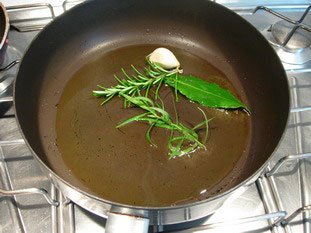Rosemary, as I’m sure you know, is a culinary herb:

It is one of the famous French “herbes de Provence”, and is very effective in bringing a real taste of the Mediterranean to any dish.
The classic way to use it in a recipe is to add a sprig or two and leave it in during cooking as a way of capturing the full flavour.
But there are two slight problems with this:
1) Rosemary, rather like bay leaves, is difficult to eat. The thick stem is usually woody and hard, and the needle-like leaves are tough, even after cooking.
2) After they have been cooking for a while, the leaves fall off the stem and get mixed into the dish. They are not ideal to eat, as I was saying, so can be unpleasant when they end up in a mouthful. Trying to sort them out of the food is an irksome task.
With such drawbacks, one might be forgiven for wanting to give up using rosemary all together, but that would be a pity, as the flavour is so good. Fortunately, there’s a solution…
The trick is a simple one, and it’s this: imagine you are making a tomato sauce, as you might knock up in advance for home-made pizzas (a real must!). Midway through cooking, once the tomatoes start to look like a proper sauce, add the sprig(s) of rosemary as planned and leave in the sauce – but only for five minutes, then remove and discard.

This will give your sauce plenty of rosemary flavour, but without leaving the nasty hard bits of herb mentioned above. Five minutes may not sound like very long, but it’s enough, as you will see.
You can do the same with thyme, but this is less necessary, as the leaves are very small and quite easy to eat.
If you are not making a sauce, but cooking meat, for example, the method is even simpler: just rub the rosemary over the meat. This might seem odd or inadequate, but it really is enough – try it out for yourself.

To sum up: When using sprigs of rosemary in a recipe, just rub over the food, or leave in the pan while cooking for no longer than five minutes.